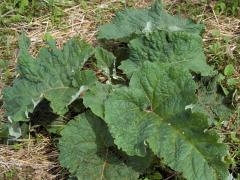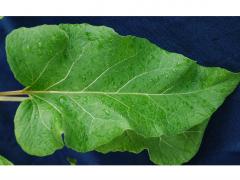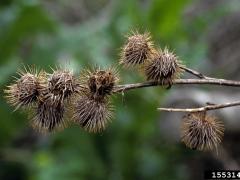Invasive Species: Arctium minus, Lesser Burdock
Lesser burdock is a tall (up to 6 ft. [1.8 m]) invasive biennial forb that occurs throughout the United States. First-year plants form large rosettes. A stout flowering stalk is formed in the second year. Stem leaves are large, heart-shaped, and very hairy on the undersides. Basal leaves are dark green, heart-shaped, and up to 1 ft. (0.3 m) long. Flowering occurs in July to October when pink to purple flowers develop. Flowers are enclosed in a prickly bur. The light brown seeds have hooks that can attach to clothing or animal fur allowing it to be distributed long distances from the parent plant. Lesser burdock can become a problematic invader of pastures, hay fields, and open prairie ecosystems. It acts as a secondary host for pathogens, such as powdery mildew and root rot, which affect economically important plants. Lesser burdock is native to Europe and came to the United States via accidental introduction.
What are invasive species and why should we be concerned about them?
Taxonomy: Scientific and Common Names for This Species
Asterales > Asteraceae > Arctium minus Bernh.
Synonym(s): bardane, beggar’s button, burdock, common burdock, small burdock, smaller burdock, wild burdock, wild rhubarb
Arctium minus – USDA PLANTS Profile
Distribution Maps
Lesser burdock – The reported distribution of this invasive species across the United States. (Source: Invasive Plant Atlas of the United States)
Up-to-the-minute distribution maps and why they are important
Reporting This Invasive Species
What is the best way and place to report the occurrence of an invasive species?
How to report an invasive species sighting to EDDMapS – Early Detection & Distribution Mapping System
EDDMapS – Report an invasive species to EDDMapS
Cooperative Extension Offices – Find your local Cooperative Extension office on this map provided by USDA
How to Identify
This invasive species can be identified by looking for the characteristics described in the paragraphs that follow.
Plant
A tall (up to 6 ft. [1.8 m]) invasive biennial forb that occurs throughout the United States. First-year plants form large rosettes. A stout flowering stalk is formed in the second year.
 |
 |
|
Ohio State Weed Lab , The Ohio State University, bugwood.org |
John D. Byrd, Mississippi State University, bugwood.org |
Foliage
Stem leaves are large, heart-shaped, and very hairy on the undersides. Basal leaves are dark green, heart-shaped, and up to 1 ft. (0.3 m) long.
 |
 |
| Theodore Webster, USDA Agricultural Research Service, bugwood.org | Bruce Ackley, The Ohio State University, bugwood.org |
Flower
Flowering occurs in July to October when pink to purple flowers develop. Flowers are enclosed in a prickly bur.
|
|
 |
|
Theodore Webster, USDA Agricultural Research Service, bugwood.org |
Mary Ellen (Mel) Harte, bugwood.org |
Fruit
The light brown seeds have hooks that can attach to clothing or animal fur allowing it to be distributed long distances from the parent plant.
 |
 |
| Ohio State Weed Lab Archive, The Ohio State University, bugwood.org | Ken Chamberlain, The Ohio State University, bugwood.org |
Native Species That Resemble Lesser Burdock
– Images at invasive.org
| bugwood.org | bugwood.org |
– Images at invasive.org
| bugwood.org | bugwood.org |
Additional Images for Lesser Burdock
Lesser burdock – Images at Invasive.org
Learning Resources for Lesser Burdock
Additional Information, Biology, Control and Management Resources
Control and management recommendations vary according to individual circumstances. Location, habitat, weather, and a variety of other conditions are factors that help determine the best treatment choice. To find the safest and most effective treatment for your situation, consult your state’s land-grant institution. If you will use chemicals as part of the control process, always refer to the product label.
United States Land-Grant University System – Find your land-grant university’s College of Agriculture, Cooperative Extension Service, or other related partner on this map provided by USDA.
Weed Identification Guide – Virginia Tech
Weed of the Week – USDA Forest Service
Flora of North America – eFloras
Fact Sheet – MissouriPlants
Jepson Herbarium – University of California

